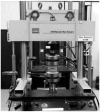Crashworthiness Investigations for 3D-Printed Multi-Layer Multi-Topology Engineering Resin Lattice Materials
- PMID: 39410413
- PMCID: PMC11477953
- DOI: 10.3390/ma17194844
Crashworthiness Investigations for 3D-Printed Multi-Layer Multi-Topology Engineering Resin Lattice Materials
Abstract
In comparison to monolithic materials, cellular solids have superior energy absorption capabilities. Of particular interest within this category are the periodic lattice materials, which offer repeatable and highly customizable behavior, particularly in combination with advances in additive manufacturing technologies. In this paper, the crashworthiness of engineering multi-layer, multi-topology (MLMT) resin lattices is experimentally examined. First, the response of a single- and three-layer single topology cubic and octet lattices, at a relative density of 30%, is investigated. Then, the response of MLMT lattices is characterized and compared to those single-topology lattices. Crashworthiness data were collected for all topology arrangements, finding that while the three-layer cubic and octet lattices were capable of absorbing 9.8 J and 7.8 J, respectively, up to their respective densification points, the unique MLMT lattices were capable of absorbing more: 19.0 J (octet-cube-octet) and 22.4 J (cube-octet-cube). These values are between 94% and 187% greater than the single-topology clusters of the same mass.
Keywords: cellular materials; cubic lattice topology; energy absorption performance; experimental techniques; octet lattice topology; stereolithography.
Conflict of interest statement
The authors declare that they have no known competing financial interests or personal relationships that could have appeared to influence the work reported in this paper.
Figures











References
-
- Banhart J. Manufacture characterisation and application of cellular metals and metal foams. Prog. Mater. Sci. 2001;46:559–632. doi: 10.1016/S0079-6425(00)00002-5. - DOI
-
- Schaedler T.A., Carter W.B. Architected Cellular Materials. Annu. Rev. Mater. Res. 2016;46:187–210. doi: 10.1146/annurev-matsci-070115-031624. - DOI
-
- Bari K., Bollenbach L. Spiderweb Cellular Structures Manufactured via Additive Layer Manufacturing for Aerospace Application. J. Comp. Sci. 2022;6:133. doi: 10.3390/jcs6050133. - DOI
-
- Najmon J.C., Dehart J., Wood Z., Tovar A. Cellular Helmet Liner Design through Bio-inspired Structures and Topology Optimization of Compliant Mechanism Lattices. SAE Int. J. Transp. Saf. 2018;6:217–235. doi: 10.4271/2018-01-1057. - DOI
Grants and funding
LinkOut - more resources
Full Text Sources

